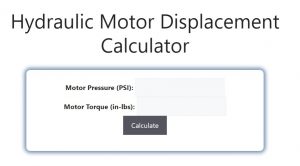About Hydraulic Motor Displacement Calculator (Formula)
The Hydraulic Motor Displacement Calculator is a valuable tool for engineers and technicians working with hydraulic systems. Understanding the displacement of a hydraulic motor is crucial for determining the performance and efficiency of hydraulic machinery. Displacement refers to the volume of fluid that the motor can displace with each rotation, directly affecting torque and power output. By utilizing this calculator, users can quickly assess the necessary motor specifications for various applications, ensuring optimal functionality and performance in hydraulic systems.
Formula
The formula to calculate hydraulic motor displacement is:
Displacement = (Motor Torque * 2 * π) / Motor Pressure
Where:
- Motor Torque is the torque output of the motor, typically measured in Newton-meters (Nm).
- π (Pi) is approximately 3.14159.
- Motor Pressure is the pressure of the hydraulic fluid in the system, typically measured in Pascals (Pa).
How to Use
Using the Hydraulic Motor Displacement Calculator is straightforward. Follow these steps:
- Gather Required Data: Measure or obtain the motor torque and hydraulic pressure values. Ensure they are in the correct units (Nm for torque and Pa for pressure).
- Input Values: Enter the motor torque and motor pressure into the calculator.
- Calculate Displacement: Click the “Calculate” button to find the hydraulic motor displacement.
- Review Results: Analyze the calculated displacement to understand the motor’s capacity for fluid movement.
Example
Suppose you have a hydraulic motor with a torque of 50 Nm and the hydraulic pressure is 200,000 Pa.
Using the formula:
Displacement = (Motor Torque * 2 * π) / Motor Pressure
Displacement = (50 * 2 * 3.14159) / 200,000
Displacement ≈ 0.00157 m³ or 1.57 liters
In this example, the hydraulic motor displaces approximately 1.57 liters of fluid with each rotation.

FAQs
- What is hydraulic motor displacement?
Hydraulic motor displacement refers to the volume of hydraulic fluid displaced by the motor per revolution. - Why is displacement important?
Displacement affects the efficiency, torque, and power output of the hydraulic motor, making it essential for system design and performance. - What units are used for motor torque and pressure?
Motor torque is usually measured in Newton-meters (Nm), while pressure is measured in Pascals (Pa). - How does the torque of a motor impact its displacement?
Higher torque generally results in greater displacement, assuming pressure remains constant. - Can I use this calculator for different types of hydraulic motors?
Yes, the calculator can be used for various hydraulic motors, provided you have the necessary torque and pressure values. - What if I don’t know the motor torque?
You can calculate torque based on the power output and rotational speed of the motor if needed. - Is the calculator accurate?
The accuracy of the calculator depends on the precision of the input values provided by the user. - How can I convert displacement from cubic meters to liters?
To convert cubic meters to liters, multiply the value in cubic meters by 1,000 (1 m³ = 1,000 liters). - What happens if the pressure is too low?
Low pressure can lead to insufficient displacement, which may affect the performance of the hydraulic system. - Is it possible to have negative displacement?
No, displacement cannot be negative; it represents the volume of fluid moved. - How does hydraulic pressure affect motor performance?
Higher hydraulic pressure typically leads to increased displacement and, consequently, greater power output from the motor. - What factors can affect the torque of a hydraulic motor?
Factors include motor design, fluid viscosity, and the operating conditions of the hydraulic system. - Can I use this calculator for other hydraulic applications?
While designed for hydraulic motors, the principles can apply to other hydraulic calculations with appropriate modifications. - What is the significance of π in the formula?
π is used to calculate the circular displacement of the motor due to its rotation. - How does temperature affect hydraulic pressure?
Increasing temperature can decrease fluid viscosity, potentially affecting pressure and performance. - What types of fluids are used in hydraulic systems?
Hydraulic fluids can include oil-based and water-based fluids, each selected based on the system’s requirements. - How often should I calculate motor displacement?
It’s advisable to calculate displacement when designing systems, making modifications, or troubleshooting performance issues. - Are there any online tools for calculating hydraulic motor displacement?
Yes, many online calculators and software tools are available for hydraulic calculations. - Can I use this formula for electric motors?
The formula is specific to hydraulic motors; electric motors operate on different principles and calculations. - What should I do if the calculated displacement seems incorrect?
Double-check your input values and ensure they are in the correct units; if issues persist, consult with a hydraulic engineer.
Conclusion
The Hydraulic Motor Displacement Calculator is an essential tool for anyone working with hydraulic systems. By providing a simple and efficient method for calculating motor displacement based on torque and pressure, users can optimize their hydraulic designs for better performance. Understanding hydraulic motor displacement allows engineers and technicians to make informed decisions, ensuring efficient operation and longevity of hydraulic machinery.